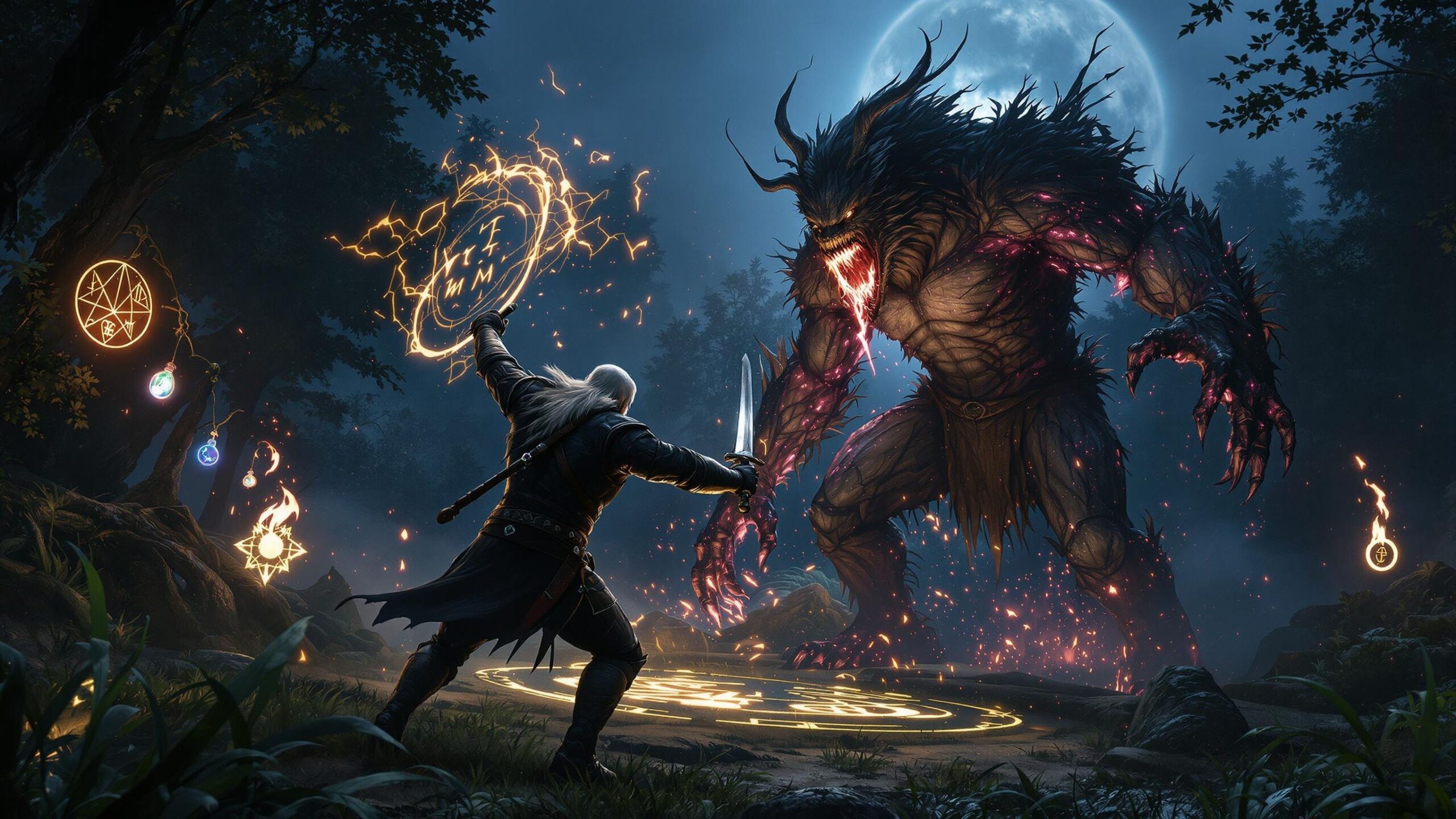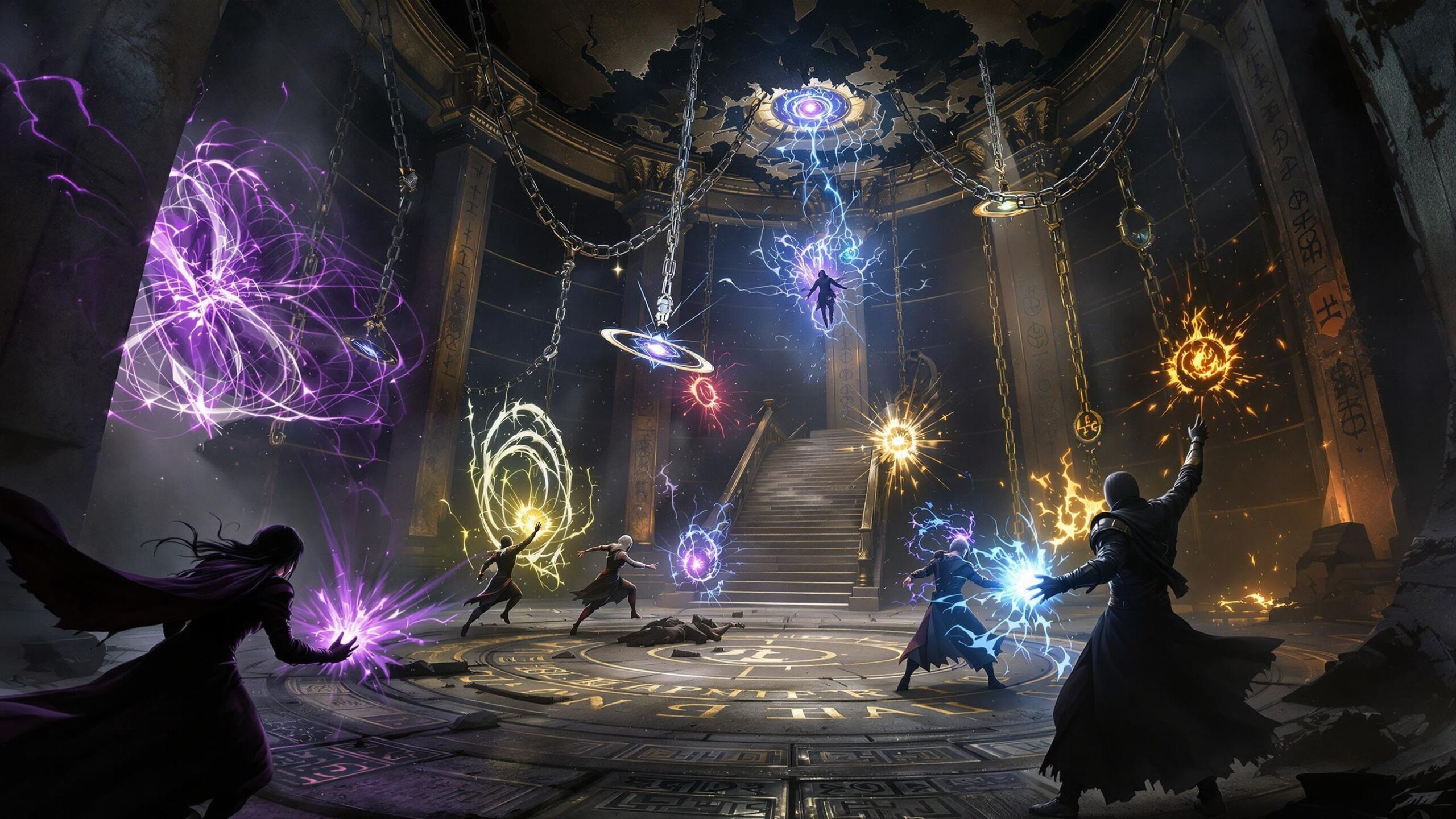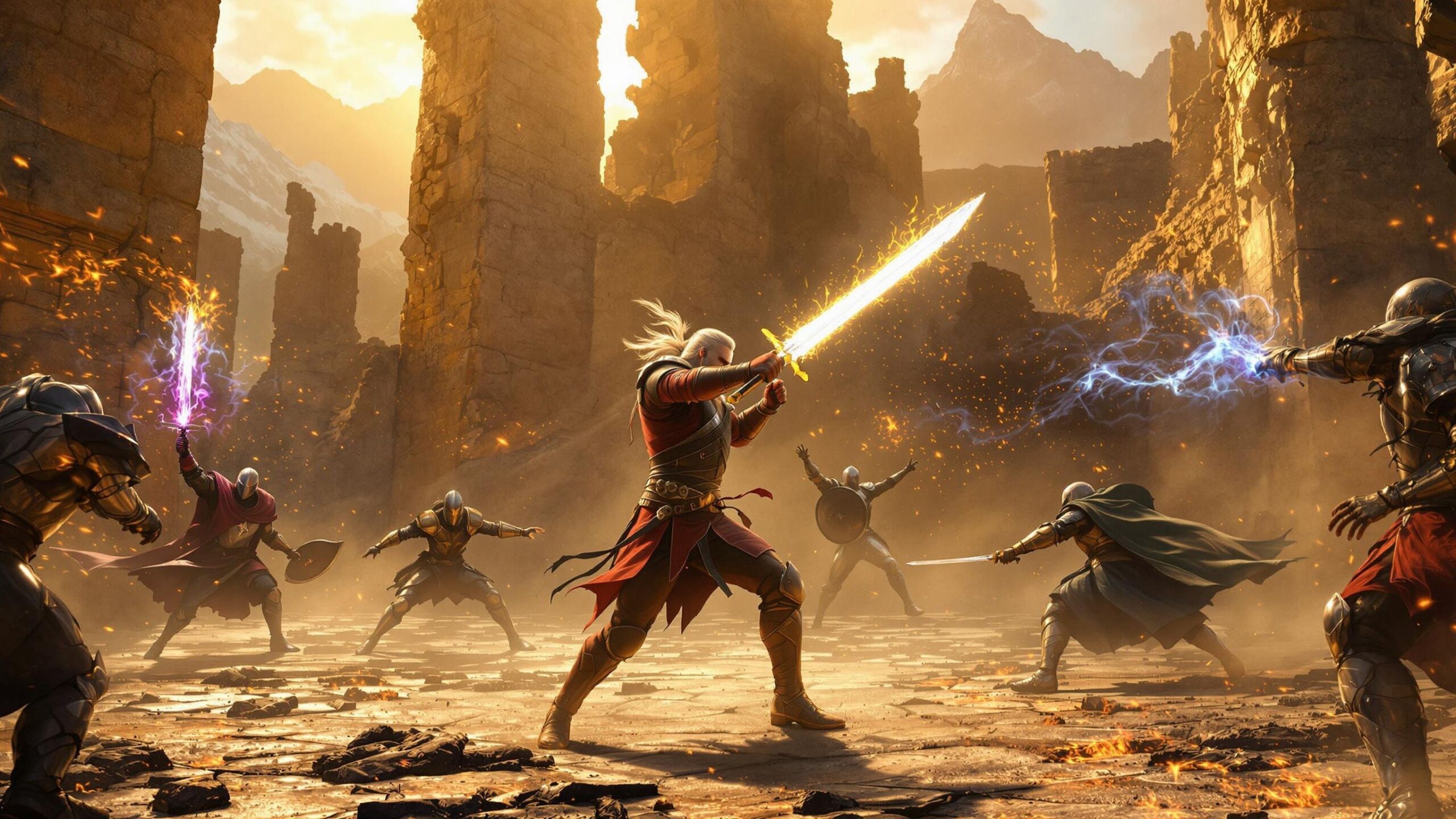Witchers aren’t just sword-swinging brutes—they’re tactical masters trained to survive the most brutal encounters imaginable. Their strength lies not only in their enhanced speed, strength, and reflexes, but in their brains. Whether fighting monsters, mages, or men, Witchers use a blend of alchemy, signs, preparation, environmental awareness, and psychological tactics to win battles that would leave ordinary warriors dead in moments. In The Witcher universe, being clever isn’t optional—it’s the only way to survive. These ten tricks highlight just how brilliant and adaptive Witchers can be when things get deadly.
#10: Geralt Using Yrden to Trap the Kayran
In The Witcher 2: Assassins of Kings, Geralt must defeat the Kayran—a massive, tentacled sea monster that has turned a harbor into its personal slaughterhouse. The Kayran is almost too large to fight head-on, so Geralt uses his environment to his advantage. First, he collaborates with a sorceress to create a special potion to protect him from the creature’s corrosive mucus. Then, during the fight itself, Geralt places the Yrden sign—normally used to immobilize smaller enemies—on key sections of the dock. When the Kayran slams down its tentacles, they become trapped by the magical snares, giving Geralt the opportunity to sever them one by one. It’s a perfect blend of magic, timing, and preparation. This fight shows that Witchers are never reckless—they plan, exploit weaknesses, and use their surroundings like true battlefield engineers.
#9: Using Axii for Mind Control and De-escalation
Axii, the Witcher sign of mental influence, might seem like a tool best used in conversation, but clever Witchers know how to use it in combat too. Axii can momentarily stun an enemy, creating an opening for a critical strike. But more tactically, it can turn one enemy against another, sowing confusion and breaking up enemy formations. Geralt has used this on everything from hostile guards to enraged deserters, buying himself precious seconds in otherwise overwhelming situations. One of the smartest applications comes when fighting multiple enemies in a cramped space—turning one into an unwitting ally who distracts others. Axii isn’t flashy, but it’s one of the most effective “soft” weapons in a Witcher’s arsenal. In The Witcher 3, it often means the difference between being mobbed and surviving with style.
#8: Using Moon Dust Bombs to Reveal Invisibility
Certain enemies—like wraiths, specters, and vampires—use invisibility or phase-shifting to dodge attacks. That’s where the Moon Dust bomb comes in. Witchers learned early that brute force is useless if you can’t see what you’re swinging at. Moon Dust disperses a magical powder that clings to ethereal enemies, forcing them into visibility. Geralt uses it expertly against specters and higher vampires like the Bruxa, who vanish mid-combat. Against Dettlaff, in particular, visibility is the key to survival. In The Witcher 3: Blood and Wine, one of the cleverest tactics Geralt employs is using Moon Dust in conjunction with Yrden to both reveal and trap enemies. He doesn’t just slash wildly—he forces the enemy into his arena, turning chaos into control. It’s one of the most cerebral tools in the Witcher toolkit.
#7: Geralt Luring Enemies into Environmental Hazards
Geralt never underestimates his terrain. Whether he’s in a collapsing mine, a swamp full of flammable gas, or a crumbling ruin, he knows how to use it. In The Witcher 3, players can lure enemies into nests of drowners, maneuver near explosive barrels, or use Igni to ignite swamp gas clouds—causing chain reactions that devastate large groups. One brilliant example is luring necrophages near beehives, baiting them into an attack, and then detonating both the bees and the monsters in a fiery blaze. Even in arena combat, Geralt uses pillars for cover, dodging around them to block projectiles or line-of-sight. A Witcher’s battlefield isn’t just a place to swing a sword—it’s a puzzle, and Geralt knows how to rearrange it to win.
#6: Using Quen’s Explosive Variant in Close Combat
The Quen sign is often viewed as a defensive tool, providing a magical shield that absorbs damage. But the upgraded version in The Witcher 3 includes a clever twist—it explodes when broken, staggering enemies and creating an opening. A smart Witcher knows how to use this to bait attacks. Geralt will sometimes take a hit on purpose to trigger the explosion, knocking back opponents and gaining momentum. This move is particularly effective against fast-striking enemies like bandits or drowners. It’s a tactical reversal—letting the enemy strike first, then using their aggression against them. A normal warrior would raise a shield and hope to survive. A Witcher makes the shield into a trap.
#5: Geralt’s Use of Potions for Situational Advantage
One of the most defining aspects of Witcher combat is alchemy. Potions like Swallow, Tawny Owl, and Thunderbolt are well-known staples, but the most clever Witcher trick lies in how Geralt times and combines these brews for maximum tactical effect. For example, before entering battle with a specter, he might consume Black Blood—a potion that causes enemies who bite or consume him to be poisoned. Against necrophages, he might pair Necrophage Oil with Golden Oriole to counteract poison and rot. Against vampires, using Cat potion to see in pitch black while the enemy remains blind can flip a disadvantage into a surprise ambush. Geralt doesn’t chug potions blindly—he prepares meticulously, matching brews to monsters, factoring terrain, and keeping toxicity levels just below lethal. It’s alchemical chess, played seconds before steel meets flesh. His pre-combat preparation is often the key to survival and one of the most underappreciated arts of Witchering.
#4: Disguising Silver Blades as Decorative or Ceremonial
In several moments across the books and games, Witchers cleverly disguise their weapons to avoid suspicion. In noble courts and guarded cities where swords are outlawed, Geralt has been known to carry his silver sword masked as a walking stick or ceremonial blade. One tale from the books mentions a time when he appeared unarmed at a formal event—only to draw a blade concealed in the spine of a staff when a cursed knight transformed. This level of deception isn’t just tactical; it’s about outthinking the enemy before the fight even starts. When monsters blend in among humans, Geralt knows his best weapon may be his ability to surprise. A Witcher’s best battle trick isn’t always in the fight—it’s being prepared to strike before anyone else even knows a fight has begun.
#3: Using Signs in Combination for Synergy
While signs are typically used individually, clever Witchers know how to combine them for devastating effect. A skilled Geralt might cast Axii to stun a target, then immediately follow up with Igni to ignite flammable armor or set the environment ablaze. Yrden slows a fast-moving enemy, creating the perfect opportunity to apply Aard and send them flying into spikes or off a cliff. In some battles, Geralt will place multiple Yrden glyphs, converting a tight space into a death trap where every enemy step activates magic. This multi-layered thinking is what separates a good Witcher from a dead one. It’s not just using power—it’s stacking effects in real time like a battlefield illusionist. Each sign may seem simple, but together, they create a deadly symphony.
#2: Faking Weakness to Lure Enemies In
Geralt has a long history of playing possum—feigning injury, fatigue, or distraction to bait his enemies. In The Witcher 3, he sometimes limps into a fight or lets opponents think he’s out of breath, only to suddenly explode into motion when their guard is down. This isn’t just about acting—it’s about exploiting arrogance. Many monsters, like fiends or wyverns, charge recklessly when they think their prey is vulnerable. Geralt can roll aside at the last second, causing them to slam into walls or traps. Against human enemies, this tactic is even more effective. They see a lone man who looks tired, perhaps even wounded—and they charge in, only to be disarmed, disemboweled, or beheaded before they realize their mistake. For Geralt, turning overconfidence into a weapon is one of his most devastating talents.
#1: Turning the Monster’s Nature Against It
Perhaps the cleverest trick a Witcher can use is to study the monster’s nature so intimately that the monster becomes the architect of its own downfall. In one of the best examples from the books, Geralt hunts a zeugl in a city’s sewer—a mutated, tentacled beast that ambushes from below. Rather than engaging it directly, Geralt deduces that its lair is beneath a weakened section of tunnel. He rigs the infrastructure above and, during the battle, baits the zeugl into striking just as he collapses the ceiling, crushing it under tons of debris. In another case, a doppler who has copied Geralt’s form believes he understands how Geralt fights—but the real Witcher surprises him with unpredictable moves and unusual signs. These are not just kills—they are outmaneuvering, like puzzles solved in the heat of battle. A Witcher doesn’t just slay monsters. He breaks them—mentally, strategically, and efficiently.
In The Witcher universe, brute force is rarely enough. Witchers survive not because they are stronger than their enemies, but because they are smarter. These tricks aren’t just gimmicks—they are refined techniques honed over decades of trial and blood. Whether it’s rigging the terrain, poisoning their own blood, or feigning weakness to draw out an enemy’s mistake, Witcher’s are combat tacticians as much as warriors. The cleverest among them—like Geralt—fight every battle like a puzzle. And in a world filled with monsters, curses, and betrayal, thinking fast is often the only way to keep breathing.




